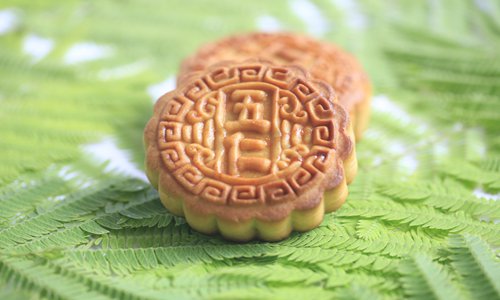China’s 1,000-year-old Mid-Autumn Festival snack continues to innovate
By Bi Mengying Source:Global Times Published: 2019/9/1 18:08:40

An wuren (five nut) mooncake Photo: IC
Every year, families throughout China gather together to enjoy some snacks and entertainment under the light of the full moon for the Mid-Autumn Festival, which is on the 15th day of the eighth month of the Chinese calendar. This year the holiday falls on September 13, less than two weeks away. While many families throughout the country and abroad celebrate the holiday in slightly different ways, one of most common and best-preserved tradition is devouring delicious mooncakes containing all manner of fillings. People often give mooncakes to their family and friends as gifts, while many companies in China hand out the festive pastry to employees as well.
While the tradition of shangyue (Lit: appreciating the moon) was practiced by many Chinese during the full moon of the eighth month - often considered to be the brightest and most beautiful full moon of the year - in ancient times, the tradition didn't become a fixed festival until the Tang Dynasty (618-907).
Pastries similar to modern mooncakes first appeared during the Song Dynasty (960-1127), but they were not exclusively enjoyed during the festival at first. As the round full moon symbolizes the reunion of families, the circular mooncakes, which are usually stuffed with sweetened bean paste, also became associated with the concept of reunion. Over the years, these tasty treats gradually became a staple of the festival and the tradition has been passed on till today.
Growing selection
There are various systems used to classify mooncakes. You can organize them by place of origin, the types of filling or whether they are sweet or salty, you name it.
"I have been eating Daoxiangcun's red and white mooncakes for over 60 years. Only old Beijingers buy these two types of mooncakes now," said an elderly customer at a Daoxiangcun shop, a pastry chain store in Beijing that was first established in 1895.
"We eat Jiangsu-style mooncakes here. The skin of the mooncakes are made up of many crispy layers. Whenever you take a bite, crumbs fall everywhere," said Xue Cha, from Qidong City in Jiangsu Province.
Meanwhile, in Shanghai, xianrou (Lit: fresh meat) mooncakes - with their juicy meat filling and golden, crispy skin - are the go-to pastry for the festival. Shanghainese cannot resist the good, old-fashioned scent of xianrou mooncakes fresh out of the oven.
"Even if you have to wait in long lines to get some xianrou mooncakes, you do it, since that's what we eat during the Mid-Autumn Festival," said Yuan Chao, who grew up in Shanghai.
In recent years, the already great selection of mooncakes has become increasingly diverse. Bingpi, or snow skin, mooncakes originating from Hong Kong have been gaining in favor in the Chinese mainland. The non-baked mooncake with fruit filling is considered by many to be a healthier alternative to traditional mooncakes that are high in sugar and contain oily fillings.
Even US ice cream maker Haagen-Dazs has thrown its hat in the ring with its ice cream mooncakes, which debuted in the Chinese mainland in 1996. With flavors such as vanilla, strawberry cheesecake, chocolate, rum raisin and green tea, the company cleverly gives the festive traditional Chinese pastry a Western touch.
With these mooncakes proving very popular among young consumers, the company has continued to expand its menu. Recently, Haagen-Dazs announced it will be selling frozen yogurt mooncakes for this year's holiday. It has also invited Liu Haoran, a popular Chinese actor, to promote the mooncakes.
Going 'nutty'
According to a report by the Xinhua News Agency, data from Chinese e-commerce giant Alibaba's online market Tmall in 2018 showed a trend toward younger consumers. Consumers 18-35 made up more than 50 percent of mooncake buyers. This has led some to wonder if traditional, old-school mooncakes will be able to survive this trend.
One of the early casualties seems to be wuren mooncakes. Meaning "five nut," wuren mooncake filling contains almonds, walnuts, pinenuts, sesame seeds and pumpkin seeds.
While wuren mooncakes remain hugely popular among older generations, they seem to be falling out of favor among younger Chinese. In recent years, many memes and catchphrases about the nutty snack have begun to spread online, such as "wuren mooncakes, please get out of the classification of mooncakes" and "if you hate someone, send them wuren mooncakes," the latter a twist on the Haagen-Dazs slogan "if you love her, take her to Haagen-Dazs."
Some people say they hate wuren mooncakes because they are not sophisticated or novel enough and yet are also one of the more expensive types.
Of course, there is no such thing as bad press. Perhaps due to wuren mooncakes' high profile on social media, sales last year saw impressive growth. According to data from Tmall, between September 1 and 17 of 2018, there were approximately 94 million keyword searches for wuren mooncakes and around 865,760 orders were placed, allowing them to enter the top three best-selling types of mooncakes on the platform.
"I tried wuren mooncakes for the first time. It was not as bad as I had heard. It was just a bit too oily," wrote one netizen on China's Twitter-like Sina Weibo.
Newspaper headline: Over the moon
Posted in: FOOD,ARTS FOCUS